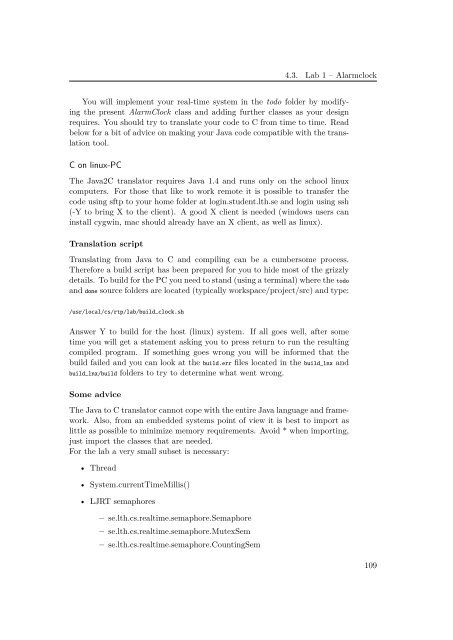JAVA-BASED REAL-TIME PROGRAMMING
JAVA-BASED REAL-TIME PROGRAMMING
JAVA-BASED REAL-TIME PROGRAMMING
You also want an ePaper? Increase the reach of your titles
YUMPU automatically turns print PDFs into web optimized ePapers that Google loves.
4.3. Lab 1 – Alarmclock<br />
You will implement your real-time system in the todo folder by modifying<br />
the present AlarmClock class and adding further classes as your design<br />
requires. You should try to translate your code to C from time to time. Read<br />
below for a bit of advice on making your Java code compatible with the translation<br />
tool.<br />
C on linux-PC<br />
The Java2C translator requires Java 1.4 and runs only on the school linux<br />
computers. For those that like to work remote it is possible to transfer the<br />
code using sftp to your home folder at login.student.lth.se and login using ssh<br />
(-Y to bring X to the client). A good X client is needed (windows users can<br />
install cygwin, mac should already have an X client, as well as linux).<br />
Translation script<br />
Translating from Java to C and compiling can be a cumbersome process.<br />
Therefore a build script has been prepared for you to hide most of the grizzly<br />
details. To build for the PC you need to stand (using a terminal) where the todo<br />
and done source folders are located (typically workspace/project/src) and type:<br />
/usr/local/cs/rtp/lab/build_clock.sh<br />
Answer Y to build for the host (linux) system. If all goes well, after some<br />
time you will get a statement asking you to press return to run the resulting<br />
compiled program. If something goes wrong you will be informed that the<br />
build failed and you can look at the build.err files located in the build_lnx and<br />
build_lnx/build folders to try to determine what went wrong.<br />
Some advice<br />
The Java to C translator cannot cope with the entire Java language and framework.<br />
Also, from an embedded systems point of view it is best to import as<br />
little as possible to minimize memory requirements. Avoid * when importing,<br />
just import the classes that are needed.<br />
For the lab a very small subset is necessary:<br />
• Thread<br />
• System.currentTimeMillis()<br />
• LJRT semaphores<br />
– se.lth.cs.realtime.semaphore.Semaphore<br />
– se.lth.cs.realtime.semaphore.MutexSem<br />
– se.lth.cs.realtime.semaphore.CountingSem<br />
109

















